
Now, I’m no seasoned explorer. I suppose would describe myself, despite having reached “Elite I” in exploration, as only actually being in the region of Scout, or maybe Surveyor. Barely halfway to being Elite. I still have a long, long way to go and there are explorers out there in the black whose ground I am not worthy to even grovel on. But that doesn’t mean I haven’t come an awful long way to get to where I am now. I’m a slow learner, I suppose, but recently I’ve felt I have finally reached phase two, if you will, of exploration expertise.

When I began exploring it was simply to choose a destination, make sure I used a ship with a seventy plus light year jump range and then get there, and back, in as few jumps as possible. Back then a system would just blend into the next system and even though I made a point of FSS scanning every single one, it seemd to take forever to get to where I was going and then, once there, even though the destination was kinda cool I was both too mind numbed by the journey out and half dreading the journey back to really take it in properly.
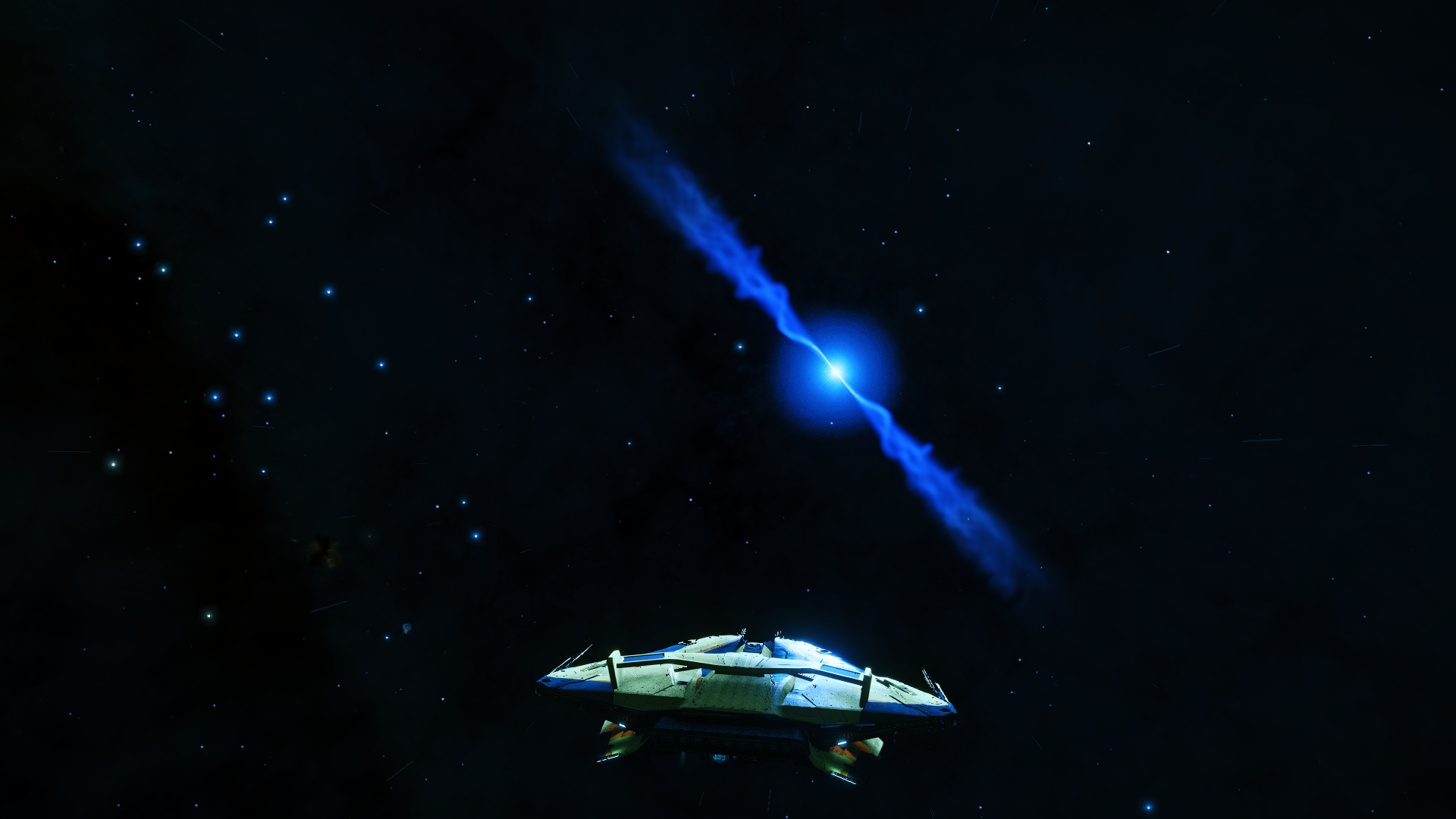
And that is basically how I conducted my exploration endeavours until I upgraded my PC and downloaded Odyssey. Now, Odyssey changed exploration completely for me, as it did for most people.
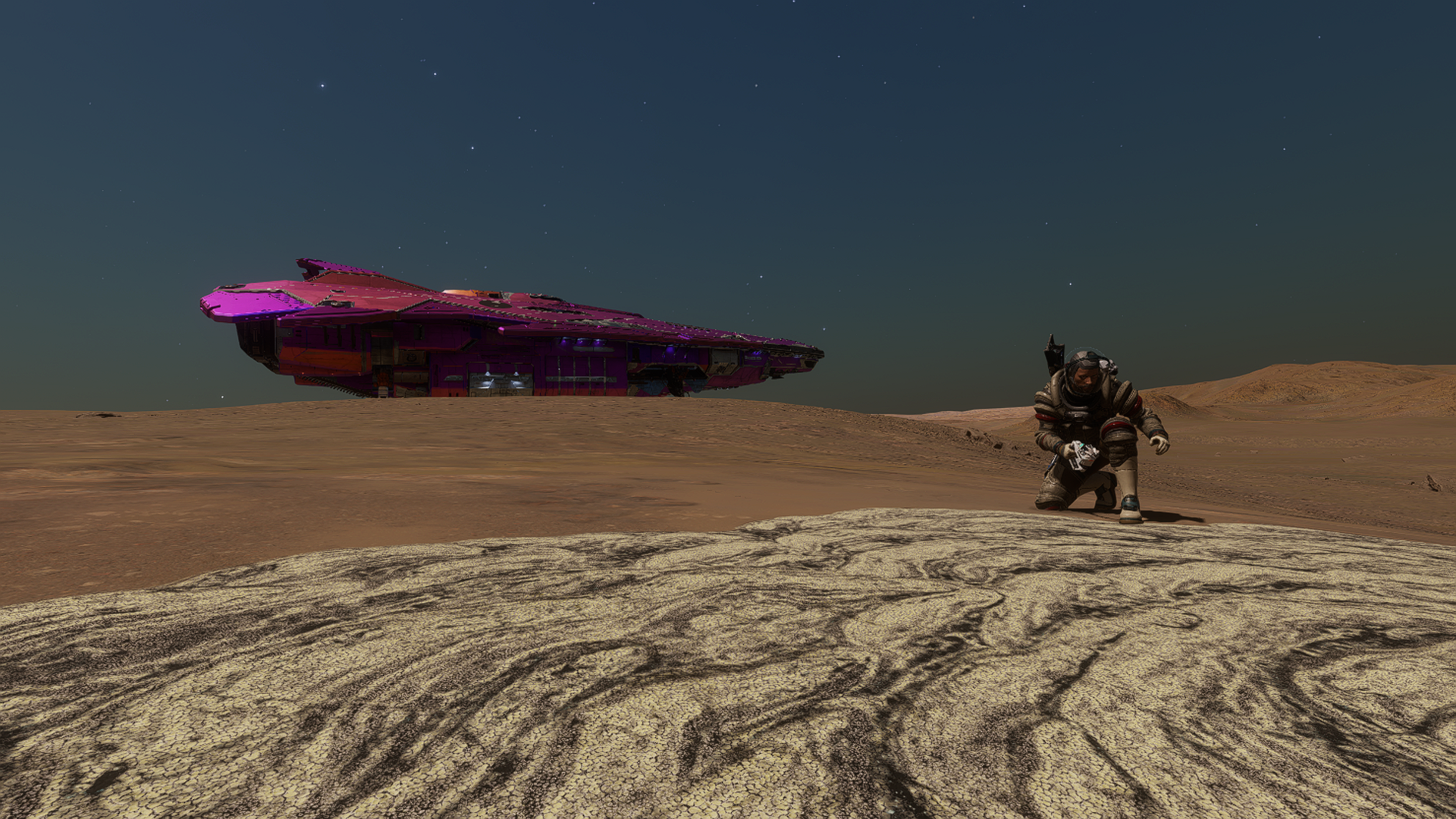
Scanning for exobiology on tenuous atmospheric worlds is a huge bonus for exploration….
On one of my alternate accounts, I travelled in a 55ly range Asp Explorer to the tip of one of the spiral arms…. 60,000 light years there and back, give or take. It took a long, long time – the best part of a year in fact, but it gave me invaluable experience. Finding exobiology became a lot easier, and I began to learn what to look for in a system that might make for an interesting screenshot. Yet I was still just picking a destination (in this case the next DSSA carrier on the way to where I wanted to go) and using the galaxy plotter to plot a direct route. Again systems just came and went and began to merge into one another and there were times when all I wanted to do was to travel the next few dozen light years as fast as possible to drop all my bio data off at the nearest Vista Genomics.
The DSSA is actually a godsend for budding explorers. Many old school explorers, before the time when the galaxy plotter would plot more than 100 light years, tend to scoff at the ease of exploration in Elite Dangerous these days. You have to hand it to them – some of them needed to use trigonometry to find their way anywhere outside the Bubble. I myself hold intrepid early explorers such as the legendary Zulu Romeo in awe. It was such a dangerous occupation back then, filled with the risk of getting lost, running out of fuel and crippling space madness due to not seeing a soul for months or even years on end. Remember – there was no engineering back then either! Now we have the Deep Space Support Array – a distribution of fleet carriers donated by wonderfully altruistic commanders, spread across the entire galaxy offering a range of services from repair and restock, to Universal Cartographics and Vista Genomics. Some even sport a bar in which exhuasted spacefarers might relax and somewhere where accident prone exobiologists might restock their first aid packs and energy cells. There are usually two in every region of the galaxy meaning there will always be somewhere reasonably nearby to land, rest, recouperate and sell your data.
Another tool that helped an immense amount around that time was my discovery of Elite Observatory. This is a fantastic little application that you can install alongside Elite Dangerous and it can tell you a number of things that may not be immediately apparent during the FSS scan. Elite Observatory will tell you, aurally if you so choose, what interesting aspects exist of any body that you scan. This can be a great tool for finding places from which to take marvellous screenshots. Close to a gas giant’s rings? Highly eliptical orbit? Ringed landable body with atmosphere? It’s all pointed out for you when you scan in case you want to investigate and view some of the astounding vistas to which it points. If there’s one thing that drives us explorers around the galaxy it’s the lure of a beautiful screenshot!
Towards the end of my alt’s journey back to the Bubble, I became fed up of exploring in the same old ship and decided to take out a ship that was immensely fun to fly rather than one that was better suited to exploration.
And so, after switching back to my original account I opted for the Imperial Courier. Not all that good for exploration really but lighten it as much as possible and give it a fully engineered FSD with a Class 3 fuel scoop and Guardian FSD booster and it has a sevicable jump range. There is still room for a couple of SRV bays, surface scanner, AFMU, shields, everything you need. Plus if you whack in some 3a enhanced thrusters from Professor Palin and fully engineer them then, because it is already rather light it will now travel very very fast.

“But you don’t need a fast ship for exploration!” I hear you wail. No, you don’t – you’re right, of course, but I didn’t want to just explore – I wanted to explore and have lots of fun. I also wanted my courier to look great so I gave her a chrome paint job and named her the Silver Machine. All part of the fun! Also I wasn’t going to travel all that far. Just a couple of thousand light years from the Bubble and back, the main focus being exobiology.
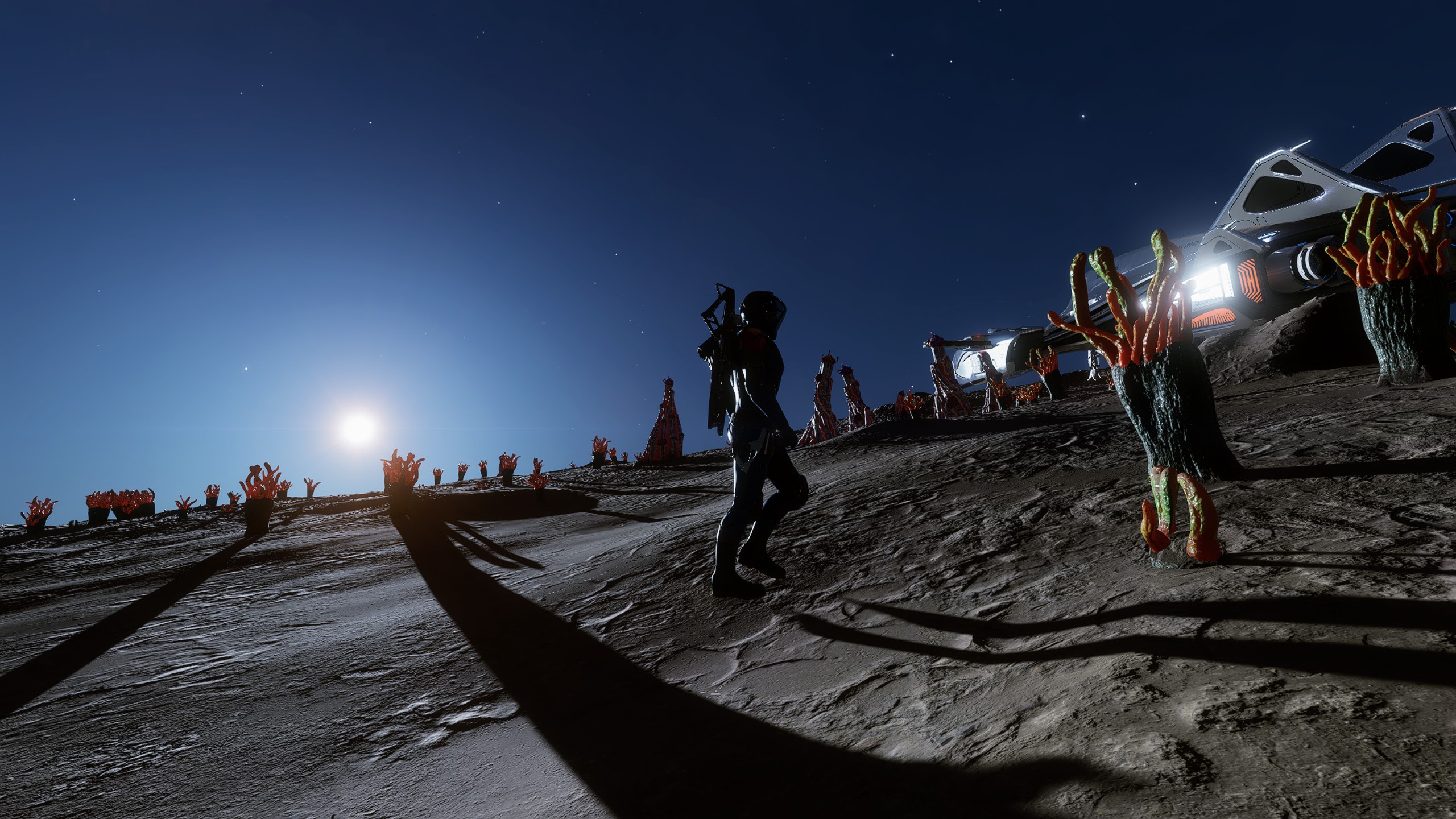
There was no planned route – I didn’t care where I went, and I discovered more in 4000 light years of travelling than I did across an entire region in my other account. Only a few first discovered systems but plenty of first footfalls, lucrative exobiology and some of the most beautiful vistas I had ever seen.

I managed to make just under a billion credits with that little trip. Up until that point it was by far the most fun I’d ever had exploring. And it was this that gave me the encouragement to fly to Colonia, scanning bios all along the way, so I could purchase a fleet carrier once I had arrived.
I have already related how that trip went. No straight lines this time, apart from when I was nearing the end, of course. I couldn’t wait to get that carrier! I meandered from nebula to nebula, finding some of the best views I had ever seen. I was getting there, exploration was slowly becoming far more joy than grind.

You may already know I have also documented my first shakedown trip with that carrier (the Esmerelda Weatherwax). I had devised a new way to travel through the galaxy by using the Spansh Fleet Carrier Route Plotter. I would send the carrier ahead, jump my hauler after it and then sending it away to the next waypoint once I had caught it up and dropped off any data I had accumulated. Culminating at the Collection of Wonders I thought it was a great way to evolve my exploring.
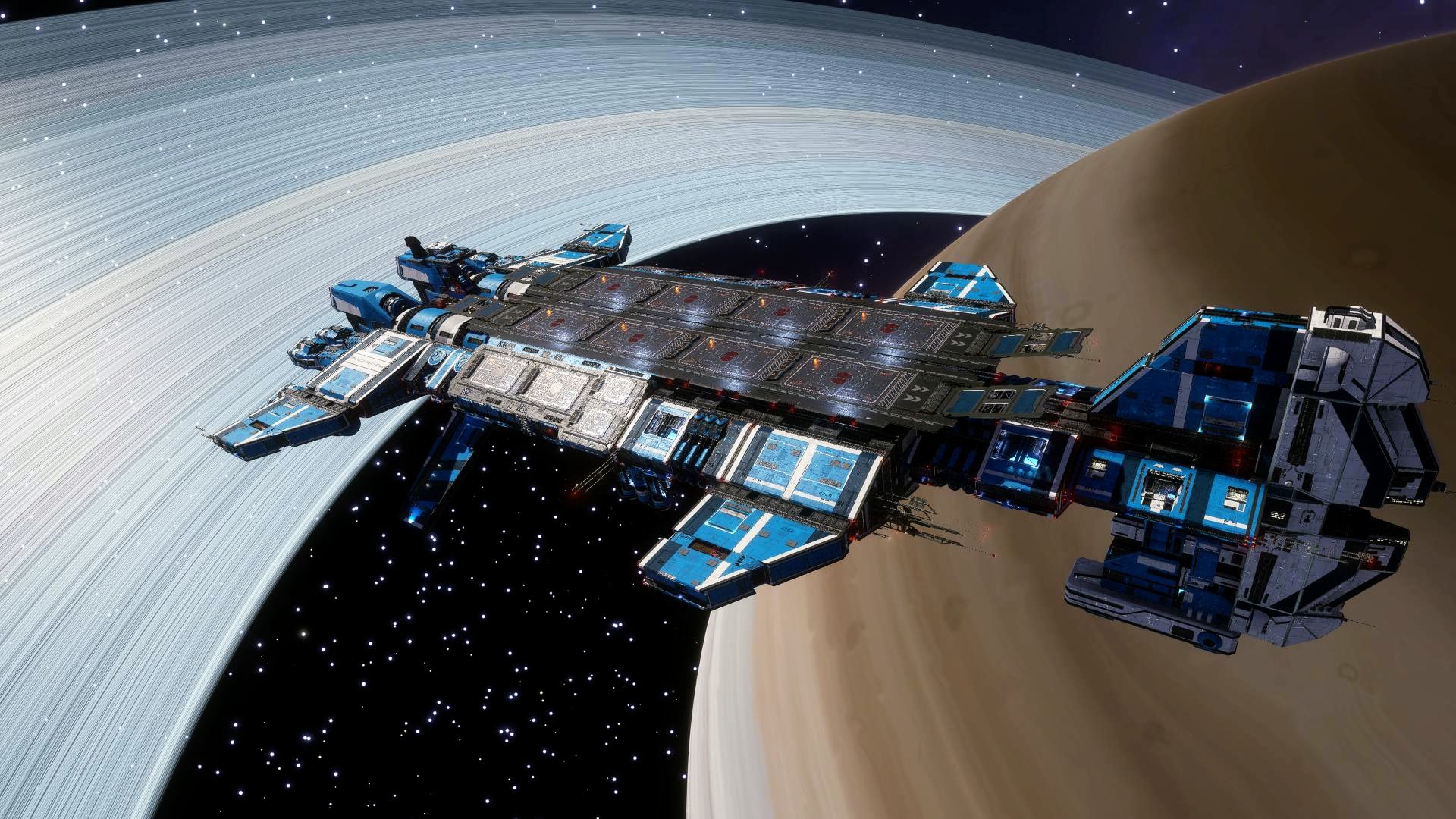
Yet once I finally began travelling away from the Collection of Wonders it felt like more of a regression. Here I was, just travelling in a stright line from system to system, just like before, and even though there was a break every dozen or so jumps, it began to feel as tedious as my first ever foray into the black. Something needed to change, and I wasn’t sure what that something was.

I thought maybe I had better fly upwards and downwards of the route the carrier was taking but I wasn’t sure what to aim for, or what to use as a lure rather than just blind jumping around. There was a nebula off in the distance but I was no longer keen. Nebulae are beautiful places to visit but almost eveyone makes a beeline for them and there isn’t all that much left to find unless you want to spend an awful lot of time in them. I like to keep on the move as much as possible. I don’t know why but I began to type in the title of the nebula on the GalMap. I began with the sector name and followed with the A-AA. Now most seasoned explorers already know this but when I did this a large list of heavy “h” mass sytems dropped down underneath the search box.

“What is a “H” mass system?” I hear some of you cry!
Lets take the very first system I “first discovered” – PLIO EURL KR-W d1-18. The “d” in the d1-18 on the end represents the mass of the system with “a” being a low mass system and “h” being a high mass system. Neutron stars tend to be at least a “d” mass whereas black holes tend to be at least “e” mass, “a” mass tend to be brown dwarfs, “b” mass red dwarfs and so on. I searched through the list of “h” mass systems, clicking on each one until I found something I had yet to see in Elite Dangerous. A wolf rayet star! It wasn’t too far either. Once I arrived there though, to my dissappointment, it was, of course, already discovered, but I seemed to have found a new way to search for interesting systems. Now, I have since discovered that most of those high mass systems are proto stars but a few of them are well worth visiting. With a bit of luck, no one else will have either!
I also used a method I had tried previously (without much patience back then – I must admit) of eliminating all the stars but the non-sequence and unusual stars from the galaxy filter, and then searching upwards and downwards of the straight line route my carrier was taking, and I noticed something I had ignored before…
In the picture on the right, the arrow points to a distant, barely visible misty dot. It’s much easier to notice as it moves while you pan the galmap up and down. The first time I noticed one I moved the galmap towards it to find out what it might be.


As you can see here this misty dot (just right and down of the centre) is now much bigger. It is just a case now of selecting each type of star in the galaxy filter until we find out exactly what it is.
Here I’ve selected and the deselected each star type until I found the correct one. It’s a proto star. Most of them seem to be proto stars, but, sometimes…well, we’ll see a bit later.

And so that is how I carried on, exploring in giant waves up to 2000 light years above and below the straight course my carrier was using. I swtiched back to the El-ahrairah’s Request so that I could travel a bit more freely like this. Finding an interesting system to head towards above, reaching it, then diving back down to the the carrier, handing in data then sending it off before diving down below to some other interesting looking system before heading back up to the carrier’s new location.
Another phenomena I discovered by only selecting the rarer star types (non squence, wolf rayet, giant carbon and white dwarfs) was a field of hundreds of white dwarfs and neutron stars. It was there that I discovered the system from whence I had my second stellar screenshot winning picture, the one at the top of the post. I was over the moon with this! It was such a beautiful system it was hard not to take a great screenshot there to be fair.

I was also trying my best to find my very first unvisited black hole. I had found plenty of them using the filter method but every one had already been discovered. One morning, I found an “f” class black hole on the way to the field of neutrons and WDs I described earlier. I travelled there, expecting to find it already had a name next to it. I reached the penultimate system, jumped, dropped out of hyperspace and….nothing on my scanner. Then it popped up out of nowhere! I was the first one here! I yelled out for joy, jumping up and almost punching a hole in the ceiling. And, by Braben, it was such a cracking system!


There are many other phenomena out there in the black that I am also eager to “first discover” and another app that has helped me immensely with this is EdCopilot. Now this wonderful toolkit can do many, many things but currently I’m using it mainly for its exploration assistance. I was now less concerned with finding bios on tenuous atmospheres (although I’m still more than up for finding some of the rarer species) and more concerned with those beautiful vistas, rare phenomena and fascinating systems. Like Observatory it will announce all sorts of useful infomation about the system you have just entered and any bodies you discover using the FSS scanner. Unlike Observatory (currently), however, it will tell you when there is a biological signal on a non atmospheric world. Now you can easily glean this particular information without any apps at all just by looking at the “FEATURES” box in the top right hand corner of the FSS scanning screen. But bio signals on non-atmospheric bodies are exceedingly rare. After hundreds of the word “NONE” in that box when scanning non-atmospherics I tend to zone out and probably would miss it but EDCopilot just blurts it out for you. It was this way that I found my very first non atmospheric lifeform.

I was using the filtered galmap search and discovered another misty dot, discovered it was a “g” mass type O star system, and plotted a route toward it. Once I arrived I was thrilled to find no else had been there and even more thrilled when EDCopilot announced after scanning the sole body orbiting it had a bio signal. A surface scan revealed Prasinum Bioluminescent Anenomes – something I have never seen up until that point. I braved the risk of both extreme high temperatures and a high gravity landing and excitedly made my way down to the surface!

As you can see I had switched this time to my DBX Hrairoo – a ship I had never used for exploration before and I am slowly falling in love with it. Once down, even on the night side of the body it was so hot I barely had enough time to run out of the ship, scan the anemone, and then get back in again before getting killed by the heat. It was a very close run thing (note: Frontier Developments need to add a thermal protection module for suits). I managed all three scans but it was far too risky to take a screenshot of my Cmdr on foot on the surface of this body!
And so my exploration endeavours continue. Again I am continually being blown away by the beauty that unfolds before my cockpit as I fly through the galaxy. I no longer use the Spansh carrier route plotter, it seems to be limited to already discovered systems so now I just forward the galmap five hundred light years towards my ultimate destination, find an interesting looking system and jump it there, then zoom up or down a couple of thousand light years in my DBX towards some curious looking phemomena. I still have a long way to go before becoming an expert explorer, but even so I feel like I have now reached the next level of exploration.
Exploration in Elite Dangerous is a slow burner. To begin with it’s tedious at best – long passages of dullness interspersed with mildly interesting curiosities. However, if one perseveres, if one can abandon the eagerness to reach the next destination, the mediocrity evaporates and is replaced by wonder at even the seemingly simplest of interstellar systems. Oddities now appear more frequently, intriguing myteries whose sirens’ song entices you away from your carefully planned route. Now exploration will deliver an overload of dopamine, as you constanty search for the nugget of gold at the end of the next rainbow. And when you find it, (and you know that you eventually will) the feeling of exaltation is unmatched by any other video game.
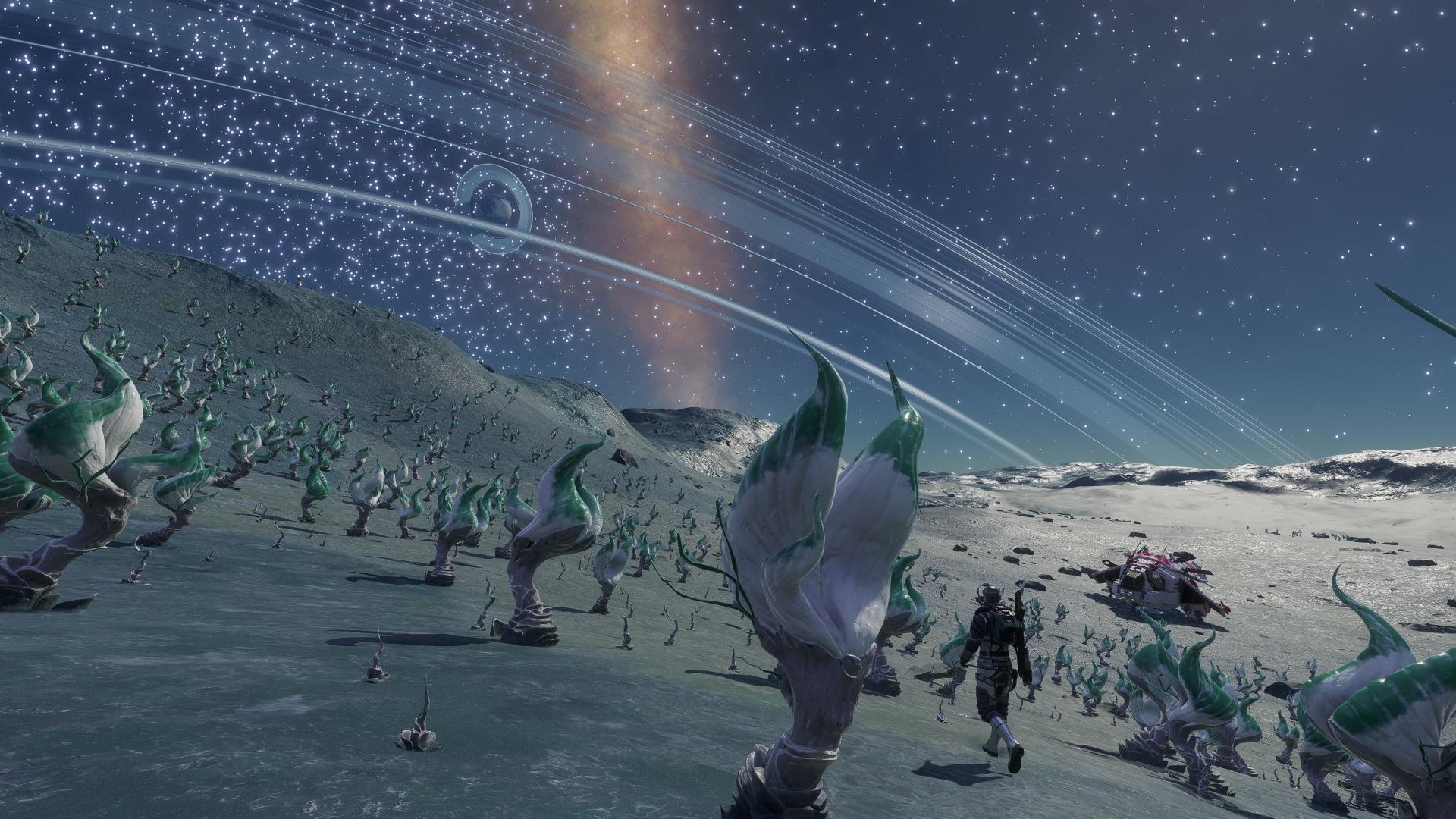

Fantastic read mate, Hugely informative and enjoyable
LikeLiked by 1 person
Ah, thanks Seawolf! It means an awful lot!
LikeLike
Great article! I don’t know if you are aware, but when you set a route you can view it in EDCoPilot and it will check each one to see if that system is known to EDSM. Systems not known of course have a higher chance of being new discoveries.
LikeLiked by 1 person
Yes! I suspected something like that when it told me I should report the planet I won the last stellar screenshot with to Canon.
And thank you! 🥰
LikeLike
Another brilliant article.
LikeLike
Thank you! This one has kinda gone ballistic. I had no idea it would have this kind of an impact.
LikeLiked by 1 person
I’ve been exploring for years now and this was how I did my exploration. Although observatory is a new tool in my arsenal to catch things I would not have otherwise bothered with. I have quite a bit of interesting systems under my belt. Mostly lost after my absence post Distant Worlds 2. I’ve been slowly finding them again. I mostly only go to giant star based systems as well as white dwarf/neutron systems and black hole systems. I also only visit F, G, and H class systems
LikeLiked by 1 person
They make great waypoints don’t they? Plus, I was surprised at how many people were unaware of the a-h mass identifiers.
LikeLike
one thing i have yet to figure out is what AK-I or the numberr following the D of F designations mean, if they do mean anything significant.
LikeLiked by 1 person
Yes. I’m not sure I’ll ever figure that one out.
LikeLike